
Nephrolepis exaltata, known as the sword fern or Boston fern, is a species of fern in the family Nephrolepidaceae. It is native to the Americas. This evergreen plant can reach as high as 40–90 centimetres (16–35 in), and in extreme cases up to 1.5 metres. It is also known as the Boston sword fern, wild Boston fern, Boston blue bell fern, tuber ladder fern, or fishbone fern.

Diplazium esculentum, the vegetable fern, is an edible fern found throughout Asia and Oceania. It is probably one of the most commonly consumed ferns.

Pellaea is a genus of ferns in the Cheilanthoideae subfamily of the Pteridaceae. The genus name is derived from the Greek word πελλος (pellos), meaning "dark," and refers to the brown stems. Many members of the genus are commonly known as cliffbrakes. They primarily grow in rocky habitats, including moist rocky canyons, slopes, and bluffs.

Pellaea andromedifolia, with the common names coffee cliffbrake and coffee fern, is a species of cliff brake fern in the Cheilanthoideae subfamily of the Pteridaceae. It is native to California in the United States and Baja California in Mexico.
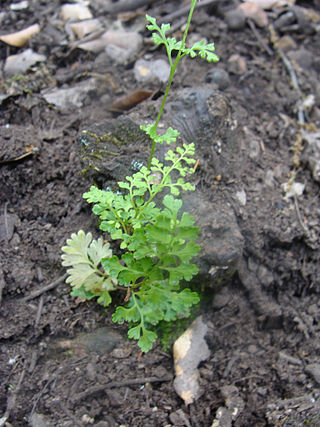
Anogramma leptophylla, sometimes called Jersey fern, is a species of fern in the family Pteridaceae. It is found worldwide in temperate and subtropical regions. A rarity in the Pteridophyta, it is a fern whose sporophyte tends to have an annual life cycle. The gametophytes of this species have the ability to become dormant and wait as much as two and a half years until conditions are appropriate for the sporophyte stage of the life-cycle.
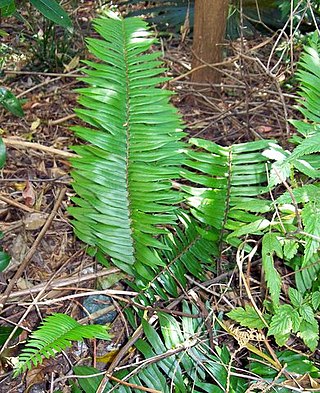
Pellaea falcata, the sickle fern, is a widespread and common plant, growing in eastern Australia. It is often seen in on the coast and ranges in eucalyptus forest and rainforest. It grows in Tasmania, Victoria, New South Wales, Queensland, and Lord Howe Island.
Cheiroglossa palmata, synonyms Ophioderma palmatum and Ophioglossum palmatum, variously known as hand fern, dwarf staghorn, or hand tongue, is an epiphytic or terrestrial fern. As an epiphyte it grows in old leaf bases of the cabbage palmetto.

Pellaea truncata is a species of fern known by the common name spiny cliffbrake. It is native to the southwestern United States and northern Mexico, where it grows in rocky areas, such as cliffs and slopes.

Pellaea calidirupium, the hot rock fern, is a fern of eastern Australia and New Zealand restricted to rocky areas in relatively arid environments. In Tasmania, where it is considered rare, it is only found on the East Coast, the Midlands, and lower slopes of the Central Plateau on dry rock faces. It is also found in Victoria and Queensland. The species was originally described from New Zealand.
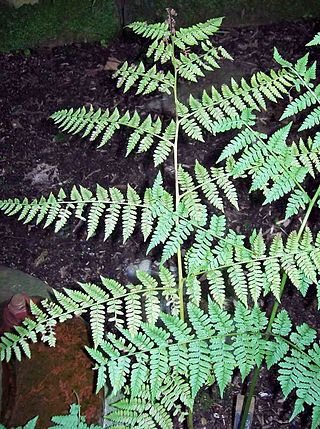
Diplazium australe, commonly known as the Austral lady fern, is a small fern occurring in eastern Australia, New Zealand and Norfolk Island. The habitat is moist shaded areas, often occurring in rainforest.

Gleichenia microphylla is a small fern growing in Australia and New Zealand.
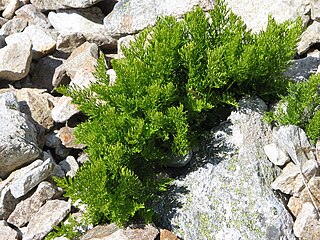
Cryptogramma crispa, the parsley fern, is an Arctic–alpine species of fern. It produces separate sterile and fertile fronds, up to 30 cm (12 in) tall, and is a pioneer species on acidic screes.
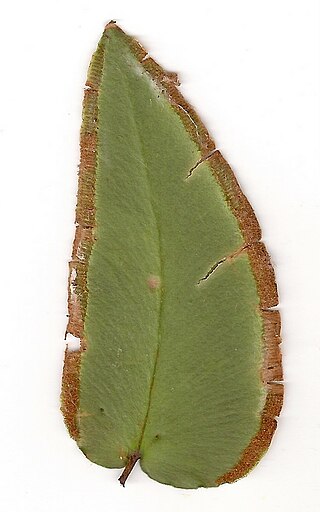
Pellaea paradoxa is a small hardy fern found north of Sydney in eastern Australia and Lord Howe Island. Often growing in or near rainforests in rocky crevices. But it may occasionally be seen in drier areas. Fronds are usually curved, 4 to 9 cm long, and 1 to 4 cm wide. Leathery to touch and a dull green. Juvenile fronds may be heart shaped. The stalks are around 1 to 5 mm long. Sori appear in a band, usually 2 to 3 mm wide, at the edge of the underside of the fronds.
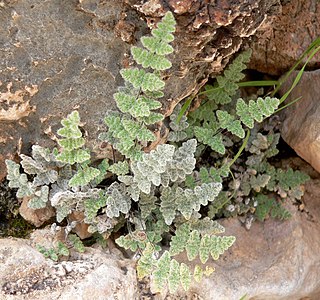
Cheilanthoideae is one of the five subfamilies of the fern family Pteridaceae. The subfamily is understood to be monophyletic, but some of the genera as currently defined are not. Most species are xeric-adapted, and the subfamily is most diverse in dry areas.

Coryphopteris simulata, synonym Thelypteris simulata, is a species of fern native to the Northeastern United States. It is known by two common names: bog-fern and Massachusetts fern. It is often confused with the silvery spleenwort, New York fern, and the marsh fern due to similarities in shape and size.

Asplenium appendiculatum, ground spleenwort, is a common native fern to Australia and New Zealand. It usually grows in cool damp conditions, among rocks, on logs or as an epiphyte.

Myriopteris alabamensis, the Alabama lip fern, is a moderately-sized fern of the United States and Mexico, a member of the family Pteridaceae. Unlike many members of its genus, its leaves have a few hairs on upper and lower surfaces, or lack them entirely. One of the cheilanthoid ferns, it was usually classified in the genus Cheilanthes as Cheilanthes alabamensis until 2013, when the genus Myriopteris was again recognized as separate from Cheilanthes. It typically grows in shade on limestone outcrops.
Argyrochosma connectens is a small cheilanthoid fern endemic to Sichuan, China. It is the only member of its genus known from Asia. Relatively rare, it is found growing in the crevices of limestone rocks in hot, dry valleys. The species was long classified in the genus Pellaea, but after a phylogenetic study in 2015 was transferred to Argyrochosma.

Argyrochosma fendleri, Fendler's false cloak fern, is a fern known from the western United States and northwestern Mexico. It grows in rocky habitats, and is distinguished from other members of the genus by its zig-zag leaf axes. Like many species in the genus, it bears white powder on the underside of its leaves. First described as a species in 1851, it was transferred to the new genus Argyrochosma in 1987, recognizing their distinctness from the "cloak ferns".

Sticherus tener, also known as silky fan-fern, is a common native ground-fern in the family Gleicheniaceae. It occurs growing along watercourses and drainage lines in rainforest that are dominated by Nothofagus cunninghamii. In Australia, it occurs in the states of Tasmania and Victoria. In New Zealand, it is known from two disjoint regions on the South Island. Like in other members of this genus, Sticherus tener have bright green fronds with repeatedly forking branches, branches bearing linear-shaped segments at almost right angles to the axis and form umbrella-like bush colony.

















